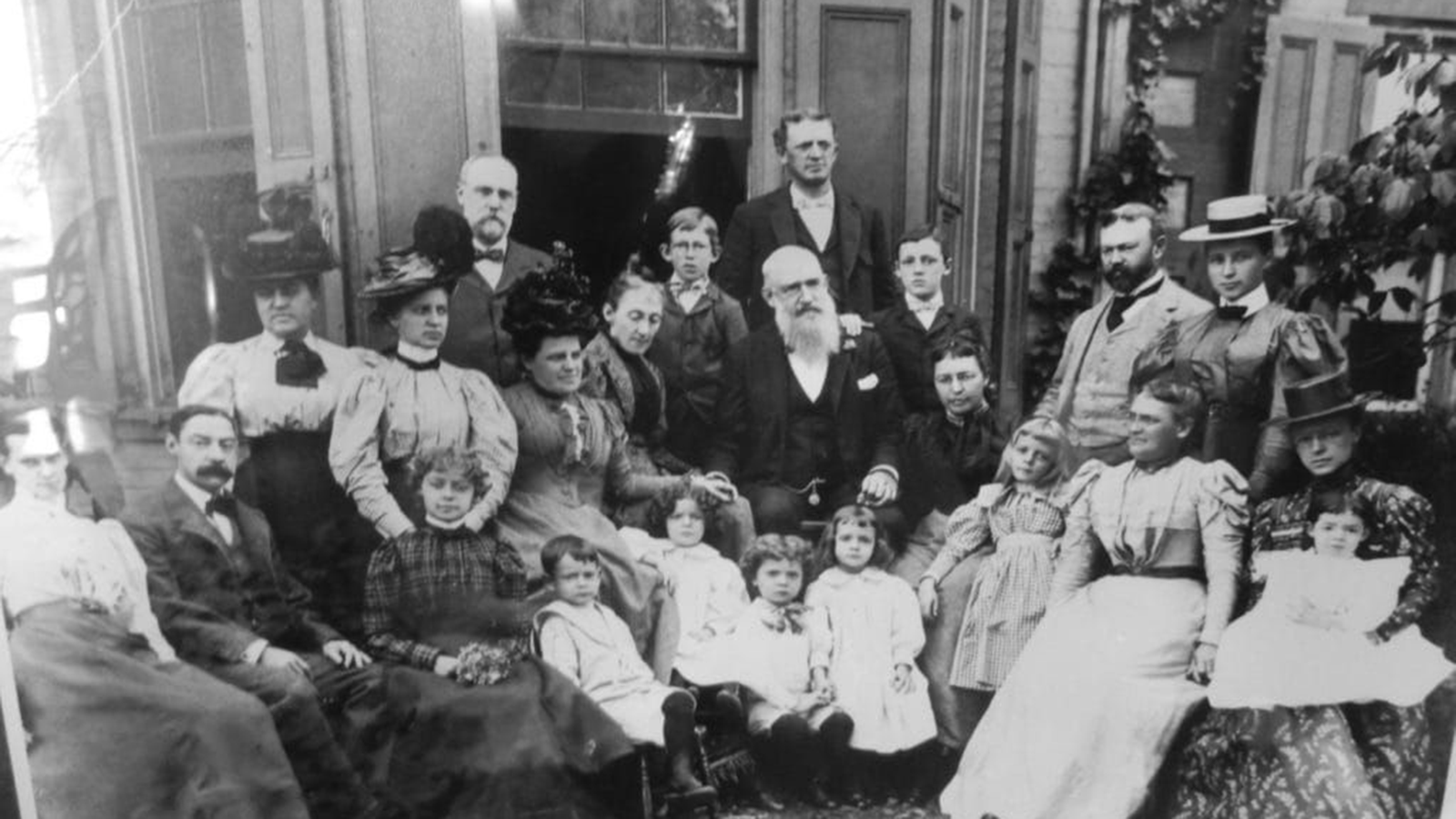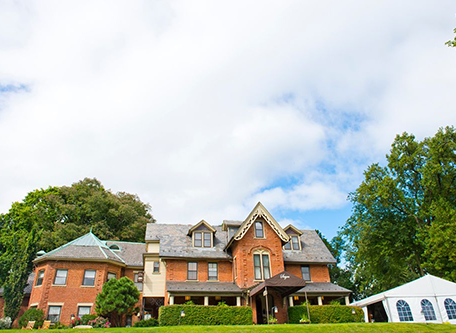Receive for Free - Discover & Explore eNewsletter monthly with advance notice of special offers, packages, and insider savings from 10% - 30% off Best Available Rates at selected hotels.
history
Discover The Sayre Mansion, which was originally built in 1858 as the private estate of Robert Heysham Sayre of the Lehigh Valley Railroad.
The Sayre Mansion, a member of Historic Hotels of America since 2013, dates back to 1858.
VIEW TIMELINEA member of Historic Hotels of America since 2013, The Sayre Mansion is listed on the U.S. National Register of Historic Places as part of the renowned “Fountain Hill Historic District.” This fantastic inn is also among the most cherished local landmarks in Bethlehem, Pennsylvania. Built on the eve of the American Civil War, The Sayre Mansion is a historic Bethlehem, PA hotel originally used as the private estate of Robert Heysham Sayre. Born in the early 1820s, Sayre initially got his start working as a lockmaster for the Lehigh Coal & Navigation Company in nearby Mauch Chuck (now modern-day Jim Thorpe, Pennsylvania). Upon gaining further career experience building canals, Sayre eventually received an appointment to help the developing Lehigh Valley Railroad extend its services into the northeastern United States. He subsequently moved his family to Bethlehem in 1854, where much of the project’s supervision was slated to take place. Selecting a plot of land in the town’s Fountain Hill neighborhood, Sayre began constructing a brilliant mansion over the next four years with a blend of Gothic Revival architecture. When work on the new home concluded in 1858, it stood as one of the most spectacular residential structures in the community.
While the mansion was under construction, Sayre continued working on the expansion of the Lehigh Valley Railroad, using the surrounding Fountain Hill area as the company’s base of operations. He sponsored the creation for dozens of administrative buildings all over the neighborhood, including the construction of the railroad’s main headquarters right down the road from his mansion. Furthermore, Sayre facilitated the development of many other outstanding palatial homes for the officers of the company, making Fountain Hill one of the most luxurious places to live in the entire Lehigh Valley. The Lehigh Valley Railroad grew significantly under Sayre’s stewardship, with its lines spreading to New York state by 1875. Demand for the railroad’s services became so great that Sayre eventually extended its network throughout the Great Lakes region as well. Sayre’s talents for business garnered him additional partnerships, and he went on to run numerous coal mines and coke factories across the country. Notably, Sayre was crucial to the creation of another one of Bethlehem's most lucrative businesses, the historic Bethelehem Steel Corporation. Within the community, Sayre engaged significantly in various philanthropic endeavors as well. He helped to establish local organizations like St. Luke's Hospital and the Cathedral Church of Nativity.
By the time Robert Sayre died in 1907, he had significantly changed Bethlehem into one of the leading manufacturing centers in the whole nation. Nevertheless, following his death, his children sold the mansion to new owners. What followed next was a period of fluid ownership, which lasted for the better part of the next seven decades. Unfortunately, time was not kind to the historic mansion, as it was left in a dilapidated state when the final residents moved out in 1988. Slated for demolition, the building was thankfully saved after John and Norah Capellano purchased the site during the early 1990s. The couple used federal tax credits to restore the structure, turning it into a historic inn called “The Sayre Mansion.” Then in 2002, the Capellanos decided to sell the location to Jeannie and Grant Genzlinger, who continued to renovate the historic mansion back to its former glory. Grant and Jeannie relied upon historic Sayre family photographs to help redecorate the inn’s interior. Today, The Sayre Mansion is a romantic, modern destination that pays respect to its significant past. Thoughtfully-restored and enhanced to include contemporary amenities, accommodations, and facilities, The Sayre Mansion offers guests the best of both the past and present.
-
About the Location +
Bethlehem itself dates back to the mid-18th century, when a small band of 14 Moravians founded a mission community at the confluence of the Monocacy Creek and Lehigh River. At the time, the area was largely inhabited by the Lenape Indians, as well as non-denominational German sustenance farmers. As such, the Moravians hoped to spread the word of their faith to the people who dwelt in that region of Pennsylvania Colony. Led by missionaries David Nitschmann and Count Nicolaus Zinzendorf, the Moravians subsequently purchased a 500-acre tract of land from William Allen. (Allen was a wealthy politician who would eventually create the nearby community of Northampton Towne—known as Allentown today—several years later.) On Christmas Eve, the Moravians gathered to celebrate the holiday season, as well as the founding of their town. While signing a hymn with the stanza, “Not Jerusalem, Lowly Bethlehem,” Count Zinzendorf petitioned his fellow missionaries to call the settlement “Bethlehem.” The count allegedly told the congregation: “Brothers, how more fittingly could we call our new home than to name it in honor of the spot where the event we now commemorate took place. We will call this place Bethlehem.”
The Moravians set about developing their town the following spring, erecting the first structures out of hewn logs from local white oak trees. Many people from the East Coast gradually moved to Bethlehem and raised their own buildings within the community. In just a handful of years, the town was home to 35 different industries that included butcheries, tanneries, smiting complexes, dye houses. There were also a few specialized shops that manufactured clocks, candles, and fine linens. As new wealth flowed into the town, so too did better building materials. Soon enough, the log cabins were replaced with grand limestone, brick, and stone structures. Some of those buildings housed a new kind of manufactory called a mill, which produced various goods. Bethlehem’s government even commissioned the creation of the first pumped municipal waterworks on the continent.
The Moravians remained pacifists during the Revolutionary War, although they geared up their factories and shops to produce resources for the war effort. They also sponsored a Continental Army Hospital at the Brethren House, where several hundred American soldiers convalesced. The Marquis de Lafayette was one of those many individuals, as he had rested in the hospital after receiving a wound at the Battle of Brandywine. Ultimately, some 500 servicemen died in Bethlehem, and their bodies were laid to rest on a hillside along First Avenue. British prisoners were billeted throughout the town as well, essentially transforming Bethlehem into a makeshift prison camp. And several members of the Continental Congress—including Benjamin Franklin and John Hancock—fled to Bethlehem when the British finally captured Philadelphia in 1777. The community fortunately transitioned well after the conflict and continued its emergence as a regional manufacturing center. People outside of the Moravian Church began buying land, denoting a shift away from the community’s earlier religious roots. (Only the church and its members were allowed to own property in Bethlehem prior to 19th century.)
The local development of canals—and later railroads—greatly transformed Bethlehem, too, for they allowed businesspeople to create more valuable goods like cigars, silk, and even refined zinc. But the greatest industrial operation in the area was the Bethlehem Steel Corporation, which grew to become the second largest producer of all steel products in the United States. Opened in 1857, the company established itself early as a significant supplier of steel goods that ranged from train track rails to military-grade ordinance. The Bethlehem Steel Corporation underwent a true metamorphosis though, when Charles M. Schwab acquired the rights to the factory in 1908. He revolutionized the business by creating the first steel I-beams at the plant, enabling architects and engineers throughout the world to construct skyscrapers for the first time. The Bethlehem Steel Corporation also became the largest shipbuilder on the planet during both World Wars, building more than 1,100 vessels in the Second World War alone. Today, Bethlehem is among the best places to vacation in the Keystone State. Its stunning scenery and cultural attractions are certain to provide for hours of entertainment.
-
About the Architecture +
The Sayre Mansion today stands as one of the best examples of Gothic Revival-style architecture in Bethlehem, Pennsylvania. Gothic Revival-style architecture itself is part of the was born from the Romanticism that swept through Europe and North America in the 19th century. This demarcated a distinctive break from the Neoclassicism of the century prior, which drew its architectural inspiration from the Greco-Roman civilizations of antiquity. The desire for the medieval design principles of Gothic Revival architecture reflected a broader trend within Western societies—particularly in Europe—to preserve the past in some meaningful way. As such, architects took to preserving the surviving buildings from the period, while also creating new ones that mirrored the aesthetic. The most common structural elements incorporated into buildings developed with Gothic Revival style was the pointed arch. This profound feature manifested in windows, doors, and rooftop gables. Yet, it also influenced the development of entire substructures, causing the creation of such features like mock parapets, conical towers, and high spires. Other characteristics associated with Gothic Revival-style architecture included a special kind of wooden trimming known as either vergeboards or bargeboards. Porches also featured turned posts or slender columns, while the roof was often deeply pitched and lined with dormers. Architects typically used this style for rural buildings set within a historic village or town, although some in the field chose it for commercial structures from time to time. Churches were perhaps the building that featured Gothic Revival style the most, as their natural layout were well-suited to showcase the best of the form.
-
Famous Historic Guests +
Woodrow Wilson, 28th President of the United States (1913 – 1921)

































